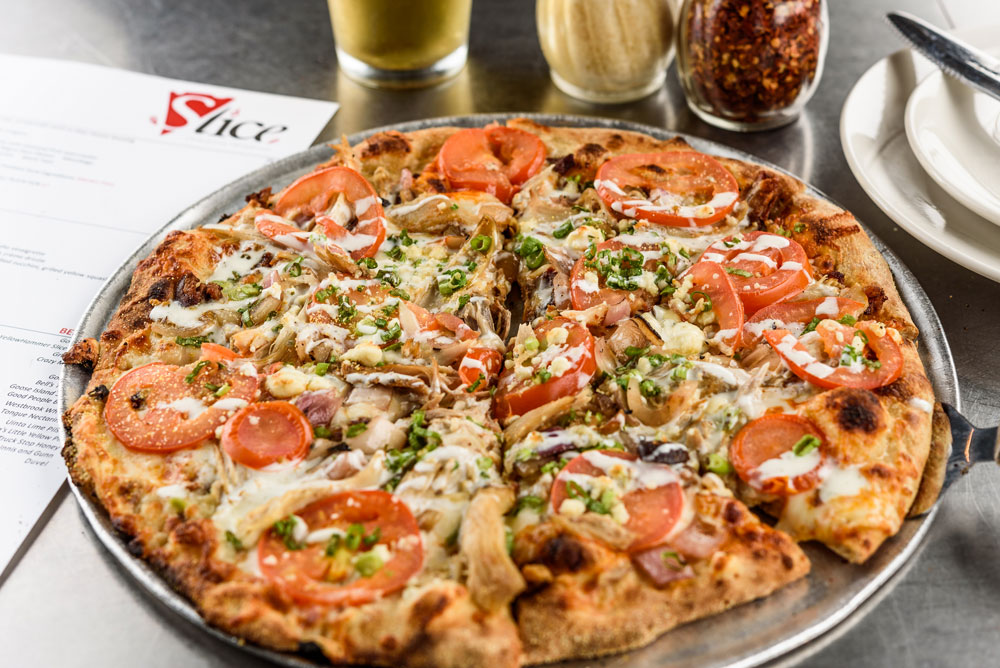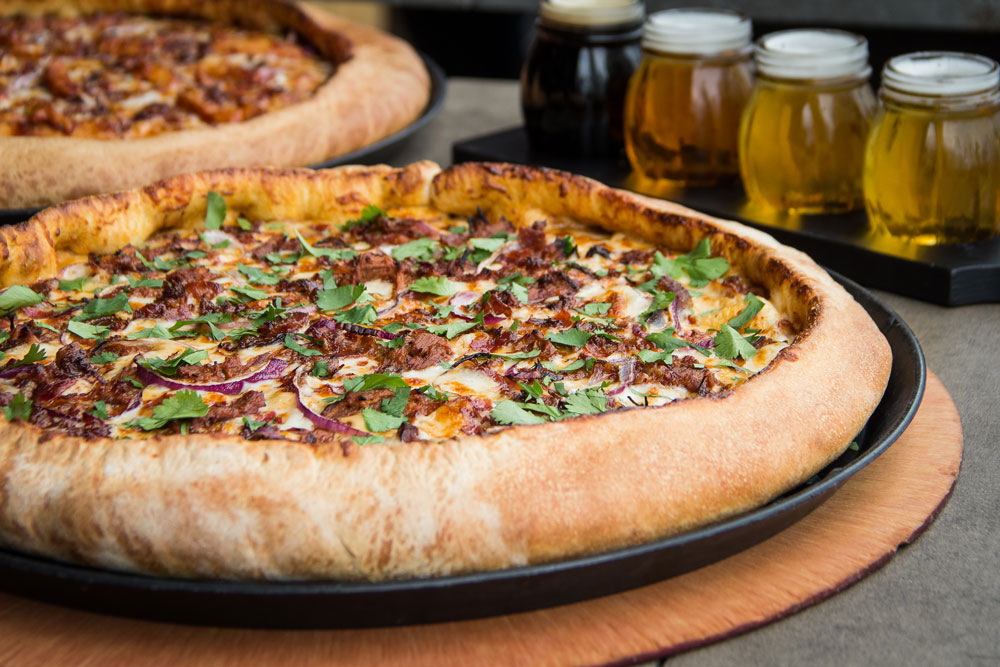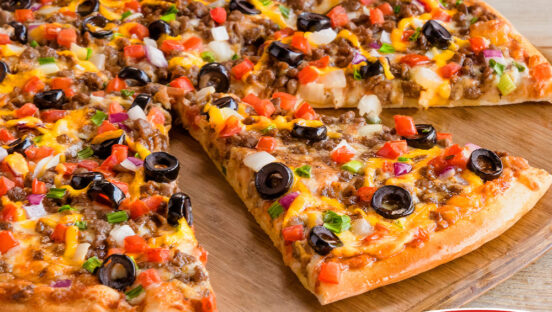Some like it hot, sure, but lately it seems like everyone is ratcheting up the heat and adding a spicy kick to foods. A July article in The Wall Street Journal reported that, according to Euromonitor, retail sales of hot sauces jumped by almost one-quarter over the past five years, to about $700 million in 2018—the biggest gain among condiments—while small brands made up 41% of the hot sauce market last year.
“Spicy condiments are responsible for 85% of the growth in overall condiment sales in the United States, and $26 million of the $31 million increase in the second quarter of 2019 was related to spicy sauces,” says David O. Figueroa Jr., president and creative director of Melinda’s Foods in Irving, Texas. “The desire for spice with condiments and food is driving consumer demand.”

At Slice Pizza & Brew, the Wing & a Prayer pie features braised chicken soaked in a hot sauce marinade.
Bringing the Heat
At Slice Pizza & Brew, with two locations in Birmingham, Alabama, co-founder/co-owner Chris Bajalieh agrees that customer demand for hot sauces has increased. “Pizzerias can try several different options: a much spicier option for a wing sauce (for tossing); a less spicy option, to be used as a pizza base; and a third option for customers’ tableside use on individual pizzas,” Bajalieh suggests. “Due to customers’ demand for diversity and varying heat sensitivity, restaurants should have at least five on hand—hot, mild, housemade, specialty and a local option.”
“Spicy condiments are responsible for 85% of the growth in overall condiment sales in the United States, and $26 million of the $31 million increase in the second quarter of 2019 was related to spicy sauces.”
— David O. Figueroa Jr., Melinda’s Foods
But how do you choose the hot sauces that will complement your food’s flavors rather than overwhelm them? Josh Huggard, manager of operational services at Boston-based Oath Pizza, focuses on spiciness (to conform to different “tolerance levels”) and flavor (to align with a premium-quality perception). “We choose a sauce that is spicy but will not ruin a person’s meal. I’d rather have a sauce that’s mild but has more flavor than a hotter sauce with less flavor, to create a taste guests love,” Huggard says. “There will always be people who think ‘the hotter, the better,’ and for them, we offer a spicier hot sauce in the dining room, so they can use as much as they can handle!”
TIP: “We mix Tabasco Chipotle with our white sauce to make our Southern Chipotle Sauce, the base for our Kickin’ Carnitas Pizza. Our Creamy Sriracha Sauce is the base for our Sriracha-Cha pizza, with pineapple, bacon, green onions and a sriracha swirl. We even have a Hot Sauce Station, where customers can try a variety of hot sauces.”
—Jeff Davis, director of operations, Woodstock’s Pizza, San Diego, CA
Figueroa calls hot sauce “a liquid alternative to your dried spice rack,” with a format that blends in quickly when added as a cooking ingredient or after cooking as a condiment. Just as many pizzerias serve dried red pepper flakes alongside their slices, he believes the ideal hot sauce brings red cayenne pepper flavor to the table, blended with ingredients that boost flavor and balance the heat of the peppers. “It isn’t the hottest pepper, bringing that balance of enough heat and flavor to not overwhelm a pizza,” Figueroa says. “Some hot sauces just use vinegar and salt, but that will make all food taste acidic, with vinegar first, pepper flavor second—hence, most likely changing and overpowering the flavor of whatever you’re making.” Finally, for true heat seekers, Figueroa recommends a ghost pepper sauce or habanero hot sauce to raise the temperature a few notches.

Woodstock Pizza’s Kickin’ Carnitas offers a hot sauce-infused base.
Into the Fire
Properly incorporating hot sauce into your recipes will also help ensure the ideal balance. At Slice Pizza & Brew, chefs consider hot sauce as a secondary ingredient for pizza base sauces or as pizza toppings, to avoid overwhelming other flavors. The Wing & a Prayer pie, for example, is topped with braised chicken that has been soaked in a hot-sauce marinade, plus bacon, green and red onions, tomatoes, blue cheese crumbles, and ranch dressing, plus a hot-sauce drizzle on top. “Hot sauces can even be used in certain base sauce recipes, as long as they’re used as a secondary spice and complement the sauce’s flavor profile,” Bajalieh adds. “For example, a tomato-base sauce would require a sweeter hot sauce to be added in place of a spice.”
TIP: “In a base sauce recipe, hot sauce plays well on thinner crusts with lighter ingredients or topped with prosciutto or other cured meats with a touch of creamy cheese.”
—Katie Borger, senior director of marketing, Boston’s Pizza Restaurant & Sports Bar, Dallas, TX
Using the right amount of hot sauce in base sauce recipes “adds another layer of flavor and can also add a mild kick,” Huggard says. “We use hot sauce to make our housemade chili oil, and for the aioli on our popular Spicy Mother Clucker pizza, with mozzarella, pickled red onions, roasted chicken, scallions, spicy aioli, and sriracha. Many of our guests put hot sauce or chili oil on all of our pizzas. It’s even a great addition to our new cheesy breadsticks.” Huggard loves to pair hot sauce with protein-based and cured meat pizzas—for example, the Luau pizza, with pulled pork and pineapple, melds smokiness, heat and cooling sweetness for a multilayered flavor explosion.
The bottom line: If you can stand the heat, don’t be afraid to get creative in the kitchen. Chances are, the hot sauce trend will continue to set mouths aflame for the foreseeable future. “People realize hot sauce not only adds more heat but also adds tremendous flavor,” Huggard concludes. “With so many hot sauces and different flavor profiles on the market, I recommend trying different types. Once you find one that’s the perfect blend for you, you’ll find yourself using it on almost everything!”
Tracy Morin is PMQ’s senior copy editor.













